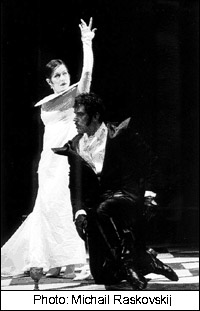Bronius Kutavičius' opera Lokys (The Bear), which premiered in June at the National Opera and Ballet Theatre, became one of last season's most important Lithuanian musical events.
From the very beginning,
Lokys, the latest stagework by Bronius Kutavičius, shown on June 25 at the
Lithuanian National Opera and Ballet Theatre, aroused not only incredible enthusiasm and controversial discussion on the part of the public and the organizers, but also fascination at its attempt to reconcile apparently intransigent things. Bronius Kutavičius, known for his abstract, pre-industrial visions and inspirations vis-à-vis archaic rituals and the mythical world, was given an opportunity to create an opera on the realistic theme of Prosper Mérimée's
Lokis. Action is developing in 19th century Samogitia (part of Lithuania), for the writer an exotic out-of-the-way place on the edge of civilization, a world of pagan sorcery and magic, where refinement clashes with barbarism, where Christianity opposes paganism, and where 'frightful' stories happen.
Librettist Aušra Marija Sluckaitė-Jurašienė and director Jonas Jurašas initiated the idea for this production. However, it was the Vilnius Festival, which solicited the help of Lithuania's major artistic energies and effected this project at the Lithuanian National Opera and Ballet Theatre in just under a month: set designer, sculptor Mindaugas Navakas, costume designer Sandra Straukaitė, and choreographer Andželika Cholina. The opera was presented for the second time on Oct. 12 at the 10th Contemporary Music Festival 'Gaida', with Inesa Linaburgytė, Irena Zelenkauskaitė-Brazauskienė, Vladimiras Prudnikovas, and Vytautas Juozapaitis in the principal roles, accompanied by the LNOBT symphony orchestra under the baton of Martynas Staškus.
In this new work, the composer, who dismissed convention in his two previous operas and oratorios, strives to implement his old idea of writing a traditional 19th century large stage opera with all its accompanying attributes - full orchestra, choir, and ballet. The choice of a libretto served as a pretext for the creation of his own
dramma per musica version, based well-nigh on the principles of classical action and naturalism. Avoiding historical and ethnographic details, Lithuanian and modern opera stereotypes, Kutavičius focused on pursuing components of intense action, incessant tension and pulsation, and an apt and suggestive fundamental of musical drama - i.e., a meaningful relationship between music and text. In the opinion of the 'Kultūros barai' reviewer, 'as always, the composer masterfully wields a full arsenal of dramaturgical means: he swiftly changes tempo and timbre, his harmonies are contrasting, his rhythms dynamic'.
© Veronika Janatjeva
Lithuanian Music Link No. 1
Though he conceived the idea of interpreting the style of 19th century opera, composer Bronius Kutavičius has remained faithful to his own musical language, his own 'minimalistic expressionism'. The composition of his musical phrases, consonances and sounds is reminiscent of conceptual poetry with its abstracted signs and symbols, and an associative structure in search of its double at the verbal level. (...) Playing alongside the alternating themes of fear, sickness, secrecy, danger, and hypocrisy - marked by a slow tempo but acoustic intensity and dissonance - are the brighter and lighter motifs of love and hope. (...) The first act, which seeks to emphasize an atmosphere of mysticism and fear, seems generally more drawn-out, thematically obscure, and lost in conflicting motifs than the second act, where the action and music are more concentrated, dynamic, clearer. It is in the second part in fact that music and direction find a greater point of contact: the ritualized wedding rites, modified polonaise, Protestant choral, stylized folk music and accompanying choir movements, and the metamorphosis of visual detail impart a feeling of celebration mixed with a foreboding of danger. (...) It is here that the kingdoms of man, the underworld, and beasts unite, and the ritual of pagan, barbaric, and modernized rites culminates.
7 meno dienos
One of the merits of this work is the fact that it allows one to choose one's own vantage point: history based on reality (the Professor from Königsberg), a mystical story (man as beast), the reflection of archetypes, or a creation of 'mixed' post-modernistic and inter-textual discourse. (...) Today, when the cinema continues to exploit the theme of this and the other world, when we are constantly being trained to accept the shocking and non-interfering 'eye' - we even have the choice of that point of view.
Kultūros barai

